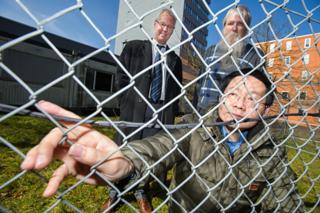Mar 26 2015
Fenced-in areas, such as airports, nuclear power stations, industrial sites, or private plots of land, can now be monitored thanks to novel sensor technology that has been developed by a team of experimental physicists, led by Professor Uwe Hartmann at Saarland University.
 From left: Professor Uwe Hartmann, Dr. Uwe Schmitt und Dr. Haibin Gao. A number of fences on the Saarbrücken campus are presently undergoing long-term monitoring. Credit: Credit: Oliver Dietze
From left: Professor Uwe Hartmann, Dr. Uwe Schmitt und Dr. Haibin Gao. A number of fences on the Saarbrücken campus are presently undergoing long-term monitoring. Credit: Credit: Oliver Dietze
The sensors respond immediately as soon as someone tries to climb over or cut through the fence, providing information on the precise location of the security breach. They are even able to detect a low-flying drone passing overhead. The thin cable containing the magnetic field sensors can be easily installed on perimeter fences of all kinds. The research team is currently working on developing the system so that it can recognize the cause of a disturbance and can automatically identify false alarms triggered by wind or animals. The team is collaborating with industrial partners to produce a cable suitable for mass production. The technology will be shown at HANNOVER MESSE from April 13th to April 17th. The team will be exhibiting at the Saarland Research and Innovation Stand in Hall 2, Stand B 46.
If someone tries to tamper with a fence, or if they try to climb over it or cut the links with bolt cutters, they will, unavoidably, cause a vibrational disturbance. The movement of the metal fence as it swings back and forth, the motion of the metal cutters or even the trespasser's belt will all influence the Earth's magnetic field. These changes are being exploited by a team of experimental physicists at Saarland University for a new type of surveillance technology. 'Our magnetometers (magnetic field sensors) are highly sensitive and can reliably measure even the smallest of changes in the ambient magnetic field,' explains Professor Uwe Hartmann. The sensors are even able to detect when a drone flies close by overhead - provided, of course, that the drone contains metal. 'The sensors can detect disturbances in the surrounding magnetic field, including the magnetic field above them, with a range extending several metres,' adds research assistant Haibin Gao who is working on the sensor technology as part of Hartmann's team.
The cable, which contains the linearly arranged sensors, has a diameter comparable to a standard electrical cable and enables the remote monitoring of miles of perimeter fencing. 'The cable can be attached to the fence, built into it or even buried beneath it. We are currently working with a number of companies to reduce the size of the system and, most importantly, to lower the cost of producing the sensors to a level where large-volume production becomes feasible,' says Uwe Hartmann. The contactless sensors are not subject to wear and have a low power consumption. They are unaffected by rain or fog. 'The sensors function independently of the weather and this gives them a significant advantage over other surveillance techniques, such as cameras, where moisture is often a problem. And the measurements are unproblematic from the point of view of privacy. The sensors simply report that a vibrational disturbance was caused by a human agent at a specific location. No other information is gathered,' explains Professor Hartmann. A number of different types of sensor systems developed by his research group have already been deployed in traffic management systems, for example in airports.
The miniature sensors in the cable are networked and any change that they register is immediately transmitted to the analyser unit. The location of the disturbance can be specified with high precision, which is of particular value when monitoring very large areas. Scientists in Hartmann's team are currently working on refining the technology so that the sensors are able to unambiguously assign a particular type of vibration or a particular change in the measured magnetic field to a specific type of disturbance. 'The aim is to develop a system that can automatically identify false alarms triggered by wind, animals or some other harmless cause,' explains Hartmann. To do this the researchers are currently simulating different types of disturbances. A number of fences on the Saarbrücken campus are presently undergoing long-term monitoring to determine how the system is affected by such factors as wind. This field data is used by the physicists to model typical disturbance scenarios and to train the system with the aid of complex mathematical methods. The results are then used to program the sensors and the analyser unit. The new information enables the analyser to automatically attribute a disturbance to a particular cause. If the cause is identified as human, an alarm is triggered; if the disturbance was due to animal rubbing up against the fence, no alarm is set off.